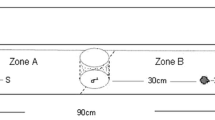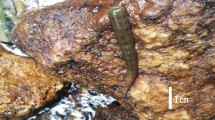Abstract
Faeces play a role in intraspecific chemical communication in many vertebrates, including lizards. Here, we hypothesised that juvenile Iberian rock lizards (Lacerta (=Iberolacerta) monticola) use substrate-borne conspecific faecal chemicals to assess the social environment and base their spatial decisions. To test this hypothesis, we prepared chemical stimuli by dissolving faeces in an organic solvent (dichloromethane, DCM) and conducted chemosensory trials where we quantified latency to the first tongue flick (TF) and TF rates when young captive-borne juveniles were placed in an arena compartment whose substrate was labelled by (1) a control (DCM), (2) their own faecal chemicals, (3) faecal chemicals of another juvenile, (4) faecal chemicals of an adult female or (5) faecal chemicals of an adult male. Following TF observations, we removed a partition that separated the labelled compartment from a chemically unlabelled one, and recorded for 5 min when juveniles first crossed to the unlabelled compartment and total time spent in the labelled compartment. Each juvenile was tested with all stimuli in a randomised order. In addition, juveniles belonged to different families and were unrelated to and unfamiliar with faeces donors. Taken together, TF and spatial responses toward stimuli indicate that juveniles discriminated between faecal chemicals of conspecific juveniles, adult females and males, and that they avoided remaining in substrates labelled by adult male faecal chemicals. We suggest that juveniles assess the social environment based on conspecific faecal chemicals thus avoiding aggression and cannibalistic risks undertaken from encounters with adult males.


Similar content being viewed by others
References
Alberts AC (1993) Chemical and behavioural studies of femoral gland secretions in iguanid lizards. Brain Behav Evol 41:255–260
Alberts AC, Phillips JA, Werner DI (1993) Sources of intraspecific variability in the protein composition of lizard femoral gland secretions. Copeia 1993:775–781
Alberts AC, Jackintell LA, Phillips JA (1994) Effects of chemical and visual exposure to adults on growth, hormones, and behavior of juvenile green iguanas. Physiol Behav 55:987–992
Aragón P, López P, Martín J (2000) Size-dependent chemosensory responses to familiar and unfamiliar conspecific faecal pellets by the Iberian rock-lizard, Lacerta monticola. Ethology 106:1115–1128
Aragón P, López P, Martín J (2001) Discrimination of femoral gland secretions from familiar and unfamiliar conspecifics by male Iberian rock-lizards, Lacerta monticola. J Herpetol 35:681–684
Aragón P, López P, Martín J (2004) The ontogeny of spatio-temporal tactics and social relationships of adult male Iberian rock lizards, Lacerta monticola. Ethology 110:1001–1019
Aragón P, Massot M, Gasparini J, Clobert J (2006a) Socially acquired information from chemical cues in the common lizard, Lacerta vivipara. Anim Behav 72:965–974
Aragón P, Meylan S, Clobert J (2006b) Dispersal status-dependent response to the social environment in the common lizard, Lacerta vivipara. Funct Ecol 20:900–907
Aragón P, López P, Martín J (2006c) Roles of male residence and relative size in the social behavior of Iberian rock lizards, Lacerta monticola. Behav Ecol Sociobiol 59:762–769
Atkins N, Jones SM, Edwards A (2002) Fecal testosterone concentrations may not be useful for monitoring reproductive status in male blue-tongued lizards (Tiliquia nigrolutea: Scincidae). J Herpetol 36:106–109
Bull CM, Griffin CL, Perkins MV (1999a) Some properties of a pheromone allowing individual recognition from the scats of an Australian lizard, Egernia striolata. Acta Ethol 2:35–42
Bull CM, Griffin CL, Johnston GR (1999b) Olfactory discrimination in scat-piling lizards. Behav Ecol 10:136–140
Bull MC, Griffin CL, Bonnett M, Gardner MG, Cooper SJ (2001) Discrimination between related and unrelated individuals in the Australian lizard Egernia striolata. Behav Ecol Sociobiol 50:173–179
Burke RD (1986) Pheromones and the gregarious settlement of marine invertebrate larvae. Bull Mar Sci 39:323–331
Carpenter GC, Duvall D (1995) Fecal scent marking in the western banded gecko (Coleonyx variegatus). Herpetologica 51:33–38
Cooper WE Jr (1994) Chemical discrimination by tongue-flicking in lizards: a review with hypothesis on its origin and its ecological and phylogenetic relationships. J Chem Ecol 20:439–487
Cooper WE Jr, Gartska WR (1987) Lingual responses to chemical fractions of urodaeal glandular pheromones of the skink Eumeces laticeps. J Exp Zool 24:249–253
Cote J, Clobert J (2007) Social personalities influence natal dispersal in a lizard. Proc R Soc Lond B 274:383–390
Danchin E, Giraldeau L-A, Valone TJ, Wagner RH (2004) Public information: from noisy neighbours to cultural evolution. Science 305:487–491
Duvall D, Graves BD, Carpenter GC (1987) Visual and chemical composite signalling effects of Sceloporus lizards fecal boli. Copeia 1987:1028–1031
Font E, Desfilis E (2002) Chemosensory recognition of familiar and novel-unused conspecifics by juveniles of the Iberian wall lizard, Podarcis hispanica. Ethology 108:1–12
Halpern M (1992) Nasal chemical senses in reptiles: structure and function. In: Gans C, Crews D (eds) Biology of the Reptilia. vol. 18. University of Chicago Press, Chicago, pp 423–523
Hanley KA, Meredith LE, Stamps JA (1999) Chemical recognition of familiar vs. unfamiliar conspecifics by juveniles iguanid lizards, Ctenosaura similis. Ethology 105:641–650
Jaeger RG, Goy JM, Tarver M, Márquez C (1986) Salamander territoriality: pheromonal markers as advertisement by males. Anim Behav 34:860–864
Johnson RP (1973) Scent marking in mammals. Anim Behav 21:521–535
Keren-Rotem T, Bouskila A, Geffen E (2006) Ontogenetic habitat shift and risk of cannibalism in the common chameleon (Chamaeleo chamaeleon). Behav Ecol Sociobiol 59:723–731
Labra A, Cortez S, Niemeyer HM (2003) Age and season affect chemical discrimination of Liolaemus bellii own space. J Chem Ecol 29:2615–2620
Léna JP, De Fraipont M (1998) Kin recognition in the common lizard. Behav Ecol Sociobiol 42:341–347
Léna JP, De Fraipont M, Clobert J (2000) Affinity towards maternal odour and offspring dispersal in the common lizard. Ecol Lett 3:300–308
López P, Martín J (2005) Intersexual differences in chemical composition of pre-cloacal gland secretions of the amphisbaenian Blanus cinereus. J Chem Ecol 31:2913–2921
López P, Aragón P, Martín J (1998) Iberian rock lizards (Lacerta monticola cyreni) assess conspecific information using composite signals from faecal pellets. Ethology 104:809–820
López P, Amo L, Martín J (2006) Reliable signalling by chemical cues of male traits and health status in male lizards, Lacerta monticola. J Chem Ecol 32:473–488
MacDonald DW (1980) Patterns of scent marking with urine and faeces amongst carnivore communities. Symp Zool Soc London 45:107–139
Main AR, Bull MC (1996) Mother–offspring recognition in two Australian lizards, Tiliqua rugosa and Egernia stokesii. Anim Behav 52:193–200
Martín J, López P (2006a) Age-related variation in lipophilic chemical compounds from femoral gland secretions of male lizards Psammodromus algirus. Biochem Syst Ecol 34:691–697
Martín J, López P (2006b) Vitamin D supplementation increases the attractiveness of males' scent for female Iberian rock lizards. Proc R Soc Lond B 273:2619–2624
Martín J, Moreira PL, López P (2007) Status-signalling chemical badges in male Iberian rock lizards. Funct Ecol 21:568–576
Martinez-Solano I (2001) Lacerta monticola (Iberian rock lizard): cannibalism. Herpetol Bull 75:30–32
Mason RT (1992) Reptilian pheromones. In: Gans C, Crews D (eds) Biology of the Reptilia. vol. 18. University of Chicago Press, Chicago, pp 114–228
Mason RT, Gutzke WHN (1990) Sex recognition in the leopard gecko, Eublepharis macularius (Sauria: Gekkonidae). Possible mediation by skin derived semiochemicals. J Chem Ecol 16:27–36
Mayer W, Arribas O (2003) Phylogenetic relationships of the European lacertid genera Archaeolacerta and Iberolacerta and their relationships to some other ‘Archaeolacertae’ (sensu lato) from Near East, derived from mitochondrial DNA sequences. J Zool Syst Evol Res 41:157–161
Moreira PL (2002) Sexual selection and sperm competition in the Iberian rock lizard (Lacerta monticola) Ph D Thesis. The University of Sheffield, Sheffield, UK
Moreira PL, Almeida AP, Rosa HD, Paulo OS, Crespo EG (1999) Bases para a conservação da lagartixa-da-montanha, Lacerta monticola. Estudos de biologia e da conservação da natureza n. 25. Instituto da Conservação da Natureza, Lisboa.
Moreira PL, López P, Martín J (2006) Femoral secretions and copulatory plugs convey chemical information about male identity and dominance status in Iberian rock lizards (Lacerta monticola). Behav Ecol Sociobiol 60:166–174
Muller KL (1998) The role of conspecifics in habitat settlement in a territorial grasshopper. Anim Behav 56:479–485
Muller KL, Stamps JA, Krishnan VV, Willits NH (1997) The effects of conspecific attraction and habitat quality on habitat selection in territorial birds (Troglodytes aedon). Am Nat 150:650–661
Müller-Schwarze D (2006) Chemical ecology of vertebrates. Cambridge University Press, Cambridge
O’Connor DE, Shine R (2005) Kin discrimination in the social lizard Egernia saxatilis (Scincidae). Behav Ecol 17:206–211
Schwenk K (1995) Of tongues and noses: chemoreception in lizards and snakes. Trends Ecol Evol 10:7–12
Siegel S, Castellan NJ Jr (1988) Nonparametric statistics for the behavioral sciences, 2nd edn. McGraw-Hill, Singapore
Simmons RR, Felgenhauer BE, Jaeger RG (1994) Salamander scent marks: site of production and their role in territorial defense. Anim Behav 48:97–103
Stamps JA (1983) The relationship between ontogenetic habitat shifts, competition and predator avoidance in a juvenile lizard (Anolis aeneus). Behav Ecol Sociobiol 12:19–33
Stamps JA (1987) Conspecifics as cues to territory quality: a preference of juvenile lizards (Anolis aeneus) for previously used territories. Am Nat 129:629–642
Stamps JA (1988) Conspecific attraction and aggregation in territorial species. Am Nat 131:329–347
Stamps JA (1991) The effect of conspecifics on habitat selection in territorial species. Behav Ecol Sociobiol 28:29–36
Van Damme R, Bauwens D, Thoen C, Vanderstighelen D, Verheyen RF (1995) Responses of naive lizards to predator chemical cues. J Herpetol 29:38–43
Waldman B, Bishop PJ (2004) Chemical communication in an archaic anuran amphibian. Behav Ecol 15:88–93
Acknowledgements
We thank the ‘El Ventorrillo’ MNCN-CSIC (Madrid, Spain) field station for use of their facilities. Research was supported by a postdoctoral fellowship from FCT (SFRH/BPD/14939/2004) to PLM and a MEC project (CGL2005-00391/BOS) to JM and PL. Animals were used for experimentation under license (85/2005/CAPT) from DAC-ICNB, Portugal.
Author information
Authors and Affiliations
Corresponding author
Additional information
Communicated by P. McGregor
Rights and permissions
About this article
Cite this article
Moreira, P.L., López, P. & Martín, J. Discrimination of conspecific faecal chemicals and spatial decisions in juvenile Iberian rock lizards (Lacerta monticola). acta ethol 11, 26–33 (2008). https://doi.org/10.1007/s10211-007-0038-6
Received:
Revised:
Accepted:
Published:
Issue Date:
DOI: https://doi.org/10.1007/s10211-007-0038-6




